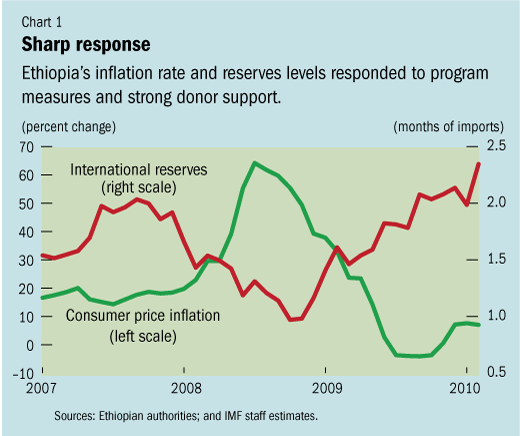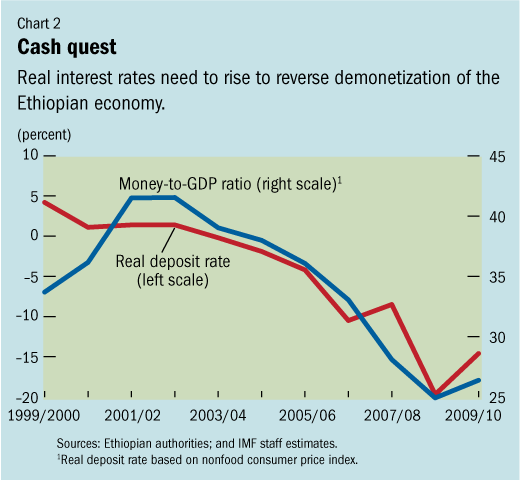ECONOMIC HEALTH CHECK

Typical street scene in Santa Ana, El Salvador. (Photo: iStock)
IMF Survey: For Sustained Growth, Ethiopia Needs to Promote Remonetization
June 22, 2010
- Ethiopia has moved to restore economic stability while maintaining strong growth
- Short-term priority: halt demonetization, promote financial deepening
- Prudent budget management also needs stronger revenue efforts
Ethiopia has made progress in restoring economic stability in 2009, while maintaining strong growth, the IMF says in its regular review of the country’s economy.

Market in Harari, Ethiopia: consumer price inflation, which peaked at 64 percent in July 2008, declined sharply to single digits by mid-2009 (photo: Newscom)
Ethiopia’s top short-term priority is to arrest a demonetization trend—where the economy is cash dependent and the development of more advanced and efficient payments, savings, credit, and financial tools are lagging. Monetization and financial deepening are engines of growth and development.
The government needs to urgently reform monetary and financial policy so that financial institutions can mobilize deposits with attractive interest rates and extend credit to support the growth of businesses and the economy at large. This requires higher interest rates—at least as high as the inflation rate—tighter control on the printing of money by the central bank to keep inflation low, and the lifting of credit controls on financial institutions.
Ethiopia’s real GDP growth is estimated to have eased to 7 percent in 2009/10 from near double-digit growth recorded in 2008/09, as the economy felt the impact of, but showed some resilience to, the global economic crisis.
Following commodity price surges in 2007–2008, Ethiopia experienced rising inflation and falling international reserves. Overall consumer price inflation peaked at 64 percent in July 2008 and international reserves fell to 1 month of imports at end-October 2008. In response, a policy package was adopted in late 2008 that included substantial fiscal and monetary adjustments, notably the elimination of fuel subsidies, as well as measures to protect vulnerable groups.
The IMF supported these policies through the Exogenous Shocks Facility (ESF), first in February 2009 with a low access disbursement, followed by a 14-month ESF arrangement under the high access component in August 2009.
Response to crisis
Under the reform measures, inflation declined sharply to single digits by mid-2009, aided by the sharp decline in international food and fuel prices. International reserves recovered to just over 2 months of imports at end-2009, helped by strong donor inflows and financing from the IMF (see Chart 1).

Recent policy developments reflect ongoing efforts to entrench economic stability. On the fiscal side, the budget has been managed prudently, with stronger revenue collection efforts. General government revenue rose, and expenditure was constrained in the first half of 2009/10, resulting in a repayment of domestic financing. For 2009/10 as a whole, the deficit will be reduced and domestic financing will be half the original program target.
Mirroring progress made in fiscal policy, reserve money growth has been reduced. As a result, excess liquidity in the banking system has declined from elevated levels. Bank credit to the private sector grew strongly in the room created by less government financing, but has been constrained by credit ceilings imposed by the central bank since early 2009 and interest rates remain negative in real terms.
The exchange rate was devalued twice (9 percent in July 2009 and 5 percent at end-January 2010 vis-à-vis the U.S. dollar) on top of a modest ongoing crawl depreciation. These actions, combined with the sharp fall in inflation, have brought the real effective exchange rate broadly back into equilibrium, and improved external competitiveness.
However, liberalization of the exchange regime would benefit the economy through improved access and confidence in the foreign exchange market, and unification of the official and parallel markets would free up significant efficiency gains.
Supporting structural measures include a tax reform strategy to raise government revenue from low levels, a more active liquidity management policy, enhanced monitoring of public enterprise financing, and strengthening of national account statistics.
In light of these developments, the first review of the government’s program was completed on June 11, allowing Ethiopia to draw $58.7 million.
Next steps to foster growth
Ethiopia’s 2010 Article IV consultation discussions focused on adjusting policies to reverse the demonetization trend and foster sustained growth while reducing vulnerability to shocks.
The task ahead is to urgently reform monetary and financial policy to remonetize the economy (see Chart 2). To achieve this, nominal interest rates on government securities would need to rise in conjunction with active liquidity management by the central bank, aimed at containing inflation at lower rates. Achieving positive real interest rates is a key to macroeconomic stability and development of the financial system. Going forward, an independent and active monetary policy focused on achieving low inflation will be important.

A large excess liquidity overhang in the financial system led the central bank in early 2009 to introduce bank-by-bank credit ceilings to contain the potential inflationary impact. The authorities are moving to mop up the excess liquidity so that the ceilings can be removed, as this is needed for monetization and financial deepening to take root. Fiscal policy needs to support these efforts by sustaining stronger revenue efforts and relieving the domestic financing pressures on central bank financing. To this end, a stepped-up tax collection effort is being introduced.
Concurrently financial sector supervision needs to be enhanced, especially with the large number of new private bank entrants recently, to ensure financial stability.
On the external side, a further accumulation of external reserves, liberalization of the exchange regime, and lower import tariffs are needed to enhance the resilience of the economy. Over time, sustained high export growth and import substitution will require vigorous implementation of productivity enhancing structural policies, including financial sector competitiveness, and improvements in the business climate.
An updated debt sustainability analysis shows that Ethiopia is in the low risk range of public external debt distress, providing room for more external borrowing. However, external borrowing, especially on commercial terms, needs to be carefully managed and directed to projects that demonstrate a high rate of return.







